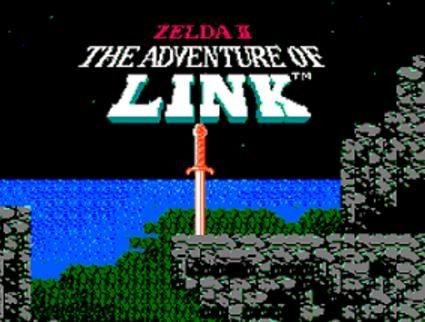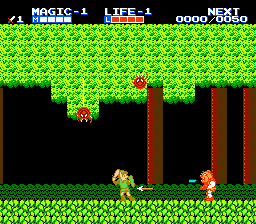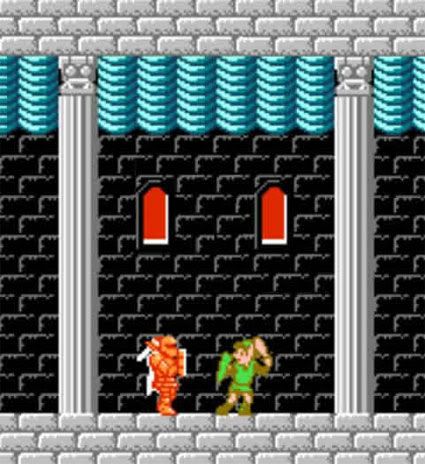Runner-Up in Review Wars II, over at the Escapist.

The first of many sword-in-the-ground opening screens.
I cherished my golden cartridges as a child. The original Legend of Zelda was one of the first Nintendo games we owned and I played it like it was going out of style. My sisters and I mapped out every dungeon for each other, as this was back in the days before GameFAQs or the Internet or internal combustion. It was innovative and challenging, and when a sequel was announced the children in the house were understandably excited. This was, as I’ve intimated, a more innocent time before I realized how disappointing sequels could be when they simply retread the ground covered by the first installment – but even now, I’d have been impressed by it.

Ten-year-old me: “This is a Zelda game? GNARLY!”
Instead of rehashing the top-down interface of the first game, the designers took it in a different direction, a similar direction to Castlevania. The Adventure of Link is a side-scrolling adventure-RPG, full of the familiar foes from the first games seen from this new perspective. I had no idea moblins were taller than Link. Anyway, replacing the sub-items such as the boomerang and bombs is a magic system, and Link has moves at his disposal other than “slash” and “toss my sword with power.” Other than that, there’s dungeons that need to be conquered in a specific order, a mysterious Big Bad at the end of it all and a damsel in distress named Zelda who needs rescuing.
Stuff I Didn’t Like

Wait, what? Already?
- There’s a ‘lives’ system. It’s perhaps the most frustrating thing in the entire game, considering that neither the first game nor any one following had one, for good reason. In the first game, when Link got rocked, he’d be sent back to the beginning of the dungeon or the starting point in the overworld map. Here, there are ‘checkpoints’ that exist within the dungeons and the overworld encounters that will put you back to the start of the current room or scene. But being sent back to that checkpoint after stabbity death or being set on fire costs you one of your three lives. Once they’re gone, the game is over and you have to start from the beginning. While you’re able to continue so you don’t lose special items or experience gained, spending hours slogging through mazes only to lose your last life just as you’re about to down that frustrating boss can require a herculean effort to choose “Continue” instead of “Fuck This.”
- You can find little 1-Up dolls scattered throughout the world to help the lives situation, but there are two problems with this. First of all, unlike the heart and magic containers that permenantly boost the amount of life or magic you have, the 1-Up dolls do not permanently increase your total number of lives. They just give you an extra life to be snatched away by a jerkass Ironknuckle or a misjudged jump. Secondly, some of the dolls are on obtainable after a long sojourn across the world and fighting legions of creatures that might possibly lose you one of your lives anyway. So these, like the lives system to which they are related, are completely arbitrary.
Stuff I Liked

I hate fighting Ironknucles. I don’t hate them, just fighting them.
- This game is challenging. The Ironknuckle enemies in particular can be a real struggle, and in some case come across as more challenging than some of the ‘boss’ characters. There are a couple bosses you can defeat just by jumping repeatedly on their head (provided you have the ‘downthrust’ maneuver) and Ironknuckles will just raise their sheilds as you sit there hopping up and down on them like a flea on a hot griddle. What I like about these foes and the overall difficulty curve of this game is that it’s consistent, gradual and, as I said, challenging.
- Like the previous game, the ‘temples’ are laid out in a fairly linear fashion that help you figure out where to go next. The map is vast, and the environments are varied but it doesn’t get confusing. Like many modern games, the optional items (‘side quests’ if you will) require a little digging, but the construction of the temples and their connection act as a guide on their own without the need for a FAQ or online guide – neither of which existed in 1989.
Stuff I Loved

Yes. Yes you are.
- This was the first Zelda game and one of the first console RPGs to have NPCs that gave information, support and even quests as you progressed through the game. Instead of defeating just destroying monsters to earn new powers, you need to do some tasks that might seem menial to learn new magic spells. Some of the inhabitants of the town are interested in helping you while others just want to go about their business. And some young ladies even invite Link into their homes to restore his health. Of course older women do it too, so it’s not as sexy as it sounds.
- There are some good musical bits in this game, for a relic of the 8-bit era. The temple music in particular stands out. It’s been recycled a couple times for the Smash Brothers franchise, and it’s some of my favorite music from the Zelda series.
- Despite being laid out completely differently from the original Zelda, it feels like high fantasy adventure through and through. It established a lot of the tropes similar games follow to this day, and actually holds up after all of the years. I recently fired it up through the collector’s edition on the GameCube, and it wasn’t just nostalgia that had me enjoying it. To this day, it’s a solidly built, engrossing, challenging and very fun game.
Bottom Line: If you find yourself frustrated by the convoluted plots and overhyped CG of modern games, fire up the Adventure of Link. It’s a refreshing trip down memory lane that’s still a blast to play.



February 27, 2010 at 12:12 pm
I loved the Swordsman (Swordmasters?) They were my favorite hidden secret in the game and I remember when I first found one.
The lives thing does indeed suck hard. :/ I would often play with a Game Genie just to get infinite lives.